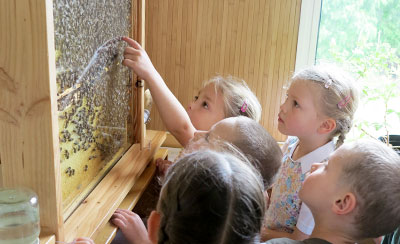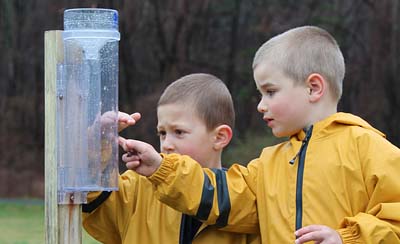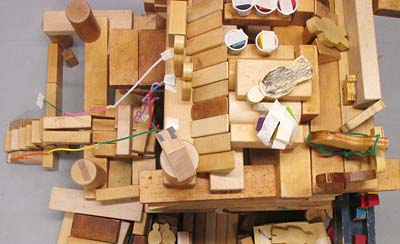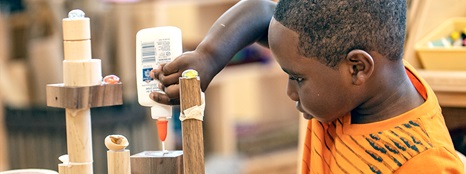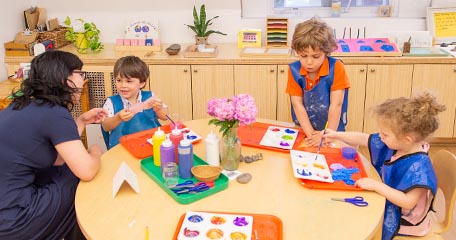The Project Approach to teaching and learning
| June 2016What is the Project Approach?
The Project Approach offers teachers a way to develop in-depth thinking while engaging the hearts and minds of young children. Teachers take a strong guidance role in the process while children study topics with purpose and flexibility. Project work presents many opportunities for young children’s ideas to be valued, their creativity to be encouraged, their interests to be nurtured, and for their learning needs to be met.
In early childhood, projects can be defined as open ended studies of everyday topics which are worthy of being included in an educational program. Projects emerge from the questions children raise and develop according to their particular interests. Rather than offering immediate answers to the questions children ask, teachers provide experiences through which children can discover the answers themselves through inquiry at field sites and interviewing experts. For example, if the children wonder what shoes are made of or how are they made, the teacher may arrange a field visit where the answer to these questions can be provided by an expert, in this case a shoe factory, the shoe repair man’s shop, or a shoe store. Children also consult secondary sources of information such as books and the internet in the classroom and with their parents at home.
Project investigations promote in-depth understanding and cover a wide range of relevant subtopics. For this reason projects usually take several weeks to complete—and sometimes much longer, depending on the age and interests of the children.
The Project Approach, then, is the method of teaching children through project investigations. Because project work follows an unpredictable path based on the interests of particular children, a flexible framework to support teachers has been developed. This framework makes the inquiry more manageable: it shapes the development of the area of investigation. Teachers guide children through a three phase process from the beginning of a project to its conclusion. You may find the Project Planning Journal helpful in understanding and implementing project work. It’s from the book Young Investigators: The Project Approach in the Early Years by Judy Harris Helm and Lilian G. Katz.
In the Project Approach teachers provide real-life experiences to promote in-depth understanding. Here children observe the activity in a beehive.
What is the structure of the Project Approach?
Phase 1:
In the beginning of a project, the teacher builds interest in the topic through encouraging the children to share relevant personal stories of experience. As the children represent their current understanding of the topic; the river, cars, or dogs, for example, the teacher assesses the children’s vocabulary, their individual interests, misconceptions or gaps in current knowledge, and helps them formulate questions which they can investigate.
Phase 2:
As the inquiry begins in earnest, teachers enable the children go on field visits, interview adults who are experts, such as waiters, farmers, or nurses, for example, according to the topic of study. Children also look at books, internet sites, videos, and so on. As they learn more about the topic they use many forms of representation to illustrate what they have learned and to share new knowledge with their classmates.
Phase 3:
Finally, the teacher guides the conclusion of the study and helps the children review their achievements. The children share their work with parents, another class, or members of the local community who have helped them in the process of the investigation. This final phase of the work includes the assessment by teachers of what the children have learned through the project. All children will have learned basic facts about the topic. Some children will have learned more about certain aspects of the topic such as the role of the adults, or the steps or materials used in the manufacture of an important item. There will be times when one child may have achieved individual learning goals such as developing confidence in a particular personal strength or learning to collaborate effectively with other classmates.
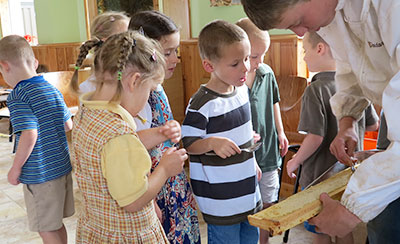
Sharing what they have learned with others helps the children to review their achievements. Here children review the achievement of the bees!
What are the advantages of the Project Approach?
When teachers encourage children’s curiosity and help them to ask questions, the study of local everyday topics becomes interesting and relevant to them. Young children’s learning is energised as they become part of a community of investigators and share the findings of their inquiry. Children apply skills and knowledge in their study of buses, shoes, trees, or grocery stores. They learn about the value of reading, writing, and numbers in the life of the adults around them. In the context of the project the children become apprentices in the pursuit of knowledge alongside their teachers. Teachers take a responsive role in developing the project. They coordinate different interests and support small group and individual inquiries as these emerge. Teachers who use the project approach report that students show great interest and actively participate. They ask questions and follow up their own curiosity with investigations.
Along with the motivation it provides, project work also integrates all areas of learning and aspects of child development. It offers many chances to practice problem solving and critical thinking—skills that build language, maths and scientific understanding. In fact, it helps children gain confidence in themselves and their abilities and develops in them the disposition to strive for understanding.
How does the Project Approach align with curriculum requirements and standards?
This type of learning differs considerably from the preplanned lessons of a published curriculum. While project work supports the curriculum standards identified for testing, teachers do not teach to the test through project work. The emphasis is on the context in which learning is intrinsically motivated and engaging to young children.
Through careful observation and skilful planning on the part of the teacher, curriculum goals can be integrated into project work. The teacher anticipates where a project may go, and includes elements of the required curriculum in her plans. For example, the curriculum goal of data collection and analysis can be incorporated into a project on cars, if children decide to count and record the kinds of cars they see. The teacher records her plan and project documentation provides evidence of learning.
In addition to the aspects of the curriculum which relate directly to the acquisition of skills and knowledge, project work offers interesting opportunities for children to apply and practice what they have learned in other parts of their daily program in school. Intrinsic motivation enables children to learn through projects in personally meaningful ways. Children who excel in certain academic areas learn to offer leadership to their peers. Children who experience difficulty in some areas frequently learn from skilled or knowledgeable peers more easily than from adults.
In classrooms where the Project Approach is well implemented, teachers and parents report that children show increased achievement and confidence in talking about what they know and can do.
Curriculum goals, such as data collection and analysis, can be naturally integrated into project work.
How does the Project Approach fit with other teaching strategies?
Project work can be incorporated into learning centres, as well as into a typical daily schedule. For example, circle time can be used to discuss a current investigation or books on the subject can be placed in the literacy area.
However, with all its advantages, most early childhood professionals would agree that project work alone does not cover all the learning experiences that should be included in the curriculum. Children learn through many different experiences in school. For young children these experiences include sensory exploration, various kinds of play activity, observation, and practice. They learn some things through direct instruction, some through small group work, some through repeated trials and persistence, and some through collaboration and lively discussion with their classmates.
The Project Approach offers children the flexibility to develop interests, to work hard at their strengths, to share expertise and make personal contributions to the work of the classroom. The use of open-ended learning centres in a classroom can make for easier differentiation by teachers in their instruction as they help children to self-assess and challenge themselves appropriately in the classroom context.
Open-ended learning centres complement project work by allowing children to reconstruct their experiences.
What are the challenges of implementing the Project Approach?
The principle challenge for teachers is to know the children well and to be able to guide them effectively in their inquiry. It requires dedication and creativity to take full advantage of individual strengths and interests, engage parental expertise (for interviews, access to field sites, etc.), and seek out resources. The key to a successful project is the teacher’s daily classroom assessment; it guides the work towards optimal learning opportunities in responsive environments for all children. These challenges demand that the teacher’s own creativity be engaged in crafting with the children the stories of their learning through projects.
As with any teaching approach or method, positive results are only evident when the teaching is done well. It is easier to set up learning centres with activities, worksheets, and boxes of props which are the same each year. It is easier to read the same fantasy literature and have the children play the parts of the characters in dramatic play year after year. In project work, teachers depend on rich communication with the children to determine their interests and prior levels of understanding. A project on ‘pets’ for instance, may focus on different subtopics from one year to the next as different groups of children and their parents show interests, expertise, or gaps in knowledge. One year the direction might be how to care for pets’ everyday needs, another year the focus might be around pet health and the work of the veterinarian, while yet another might be the work that animals can do for human beings, such as service dogs, leisure pursuits and exercise, or work with the elderly or young people with autism or other challenges. Teacher’s responsiveness to children challenges them always to bring fresh thinking to project work.
Another challenge for teachers is to plan the work so that there is a unity and cohesiveness to each project which all the children can appreciate. As various interests are developed teachers have to keep the communication focused on the value of each group’s contribution to the knowledge and understanding of the topic by all the children in their classes.
Yet, teachers wishing to help students develop a life-long love of learning and understand the interconnected relationship of all things will find there are unique advantages to project learning.
References
Beghetto, RA & Kaufman, JC (2013). Fundamentals of Creativity. Educational Leadership, Vol. 70, No. 5, pp. 10-15.
Chard, SC (2009). The Project Approach: Six Practical Guides for Teachers. These guides are available as .pdf files at the following web site: www.projectapproach.org
Katz LG & Chard, SC (2000). Engaging Children’s Minds: The Project Approach, Greenwood.

